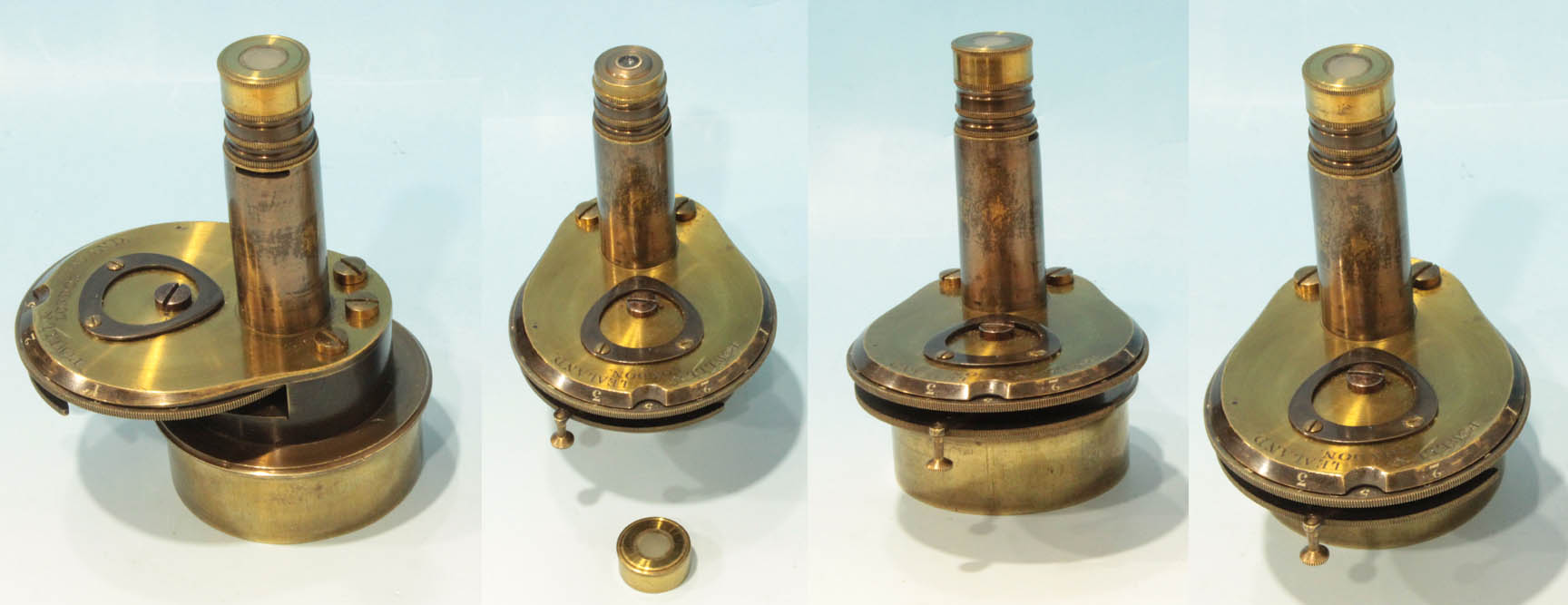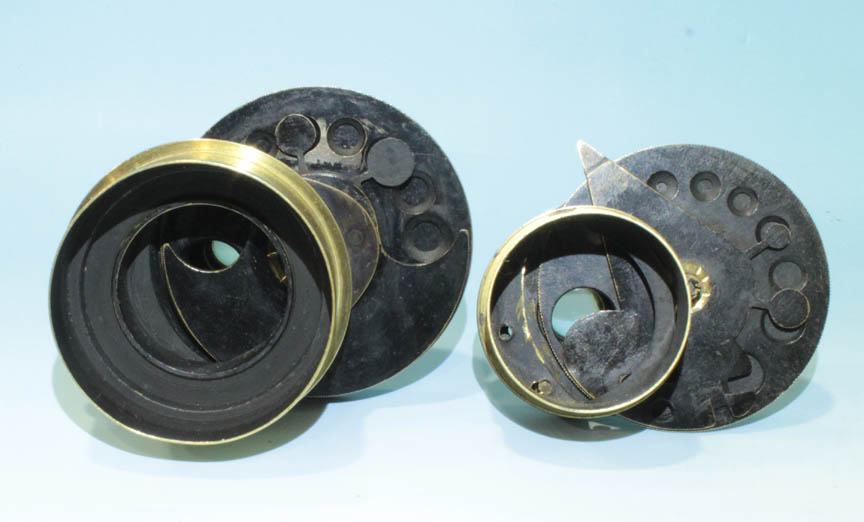MICROSCOPE-ANTIQUES.COM © 2013-23.
POWELL AND LEALAND CONDENSER
C. 1880
SIGNED ON THE CONDENSER: POWELL & LEALAND, LONDON
MODEL: HIGH POWER ACHROMATIC CONDENSER (improved version, larger type made to fit earlier Ross microscopes with 2 inch diameter substage fittings)
Author: Barry Sobel
Editors: Joseph Zeligs and Jurriaan de Groot
 This is a larger version of the Powell & lealand 'High Power Achromatic Condenser'. It was first introduced in 1857 by Powell & Lealand and this, the improved version, about 1878. This larger example is shown above installed on an earlier Ross microscope replacing a Ross Gillette condenser or the substage simple wheel of apertures shown to the side of the microscope. Unlike the smaller usual model of P & L High Power Achromatic Condenser, this one has a cap with a diffusing glass instead of a cap with a pinhole. The diffusing glass would allow more even illumination when using the Nelsonian Method of Critical Illumination. It is suitable for use with any high power (dry) objective from 1/4 inch focal length* to as powerful as a 1/8 inch focal length*, and even more powerful ('dry') objectives. It has both a wheel of apertures and also a choice of stops with the stops and the apertures controlled separately. The apertures are controlled by a knurled disk revealing white numbers in the semicircular opening, number 1 being the smallest opening and 11 the largest. Unlike the smaller type of this condenser, this one has a second disk to control the stops with a little handle projecting down. There are three numbered positions, 1,2 and 3, 1 being the smallest stop and 3 the largest, to be used with the larger apertures. There is a fourth stop, un-numbered, which leaves out any stop. Furthermore, again unlike the smaller version which has two stops and two different openings for oblique illumination and a single crescent, this larger version does not have the two oblique lighting openings but has a crescent-shaped occluder of opposite directions at each extreme of the rotation of the disk to allow a variable crescent oblique illumination of two different directions. This is in contrast to the round occluder in the smaller model, present on only one side of the disk of stops. The blackened-brass rounded-triangle piece on top of the condenser serves as a spring holding down a bearing to register the apertures so they are properly centered and stable when turned into place. A similar mechanism from the bottom acts on the disk of stops and crescents.
This is a larger version of the Powell & lealand 'High Power Achromatic Condenser'. It was first introduced in 1857 by Powell & Lealand and this, the improved version, about 1878. This larger example is shown above installed on an earlier Ross microscope replacing a Ross Gillette condenser or the substage simple wheel of apertures shown to the side of the microscope. Unlike the smaller usual model of P & L High Power Achromatic Condenser, this one has a cap with a diffusing glass instead of a cap with a pinhole. The diffusing glass would allow more even illumination when using the Nelsonian Method of Critical Illumination. It is suitable for use with any high power (dry) objective from 1/4 inch focal length* to as powerful as a 1/8 inch focal length*, and even more powerful ('dry') objectives. It has both a wheel of apertures and also a choice of stops with the stops and the apertures controlled separately. The apertures are controlled by a knurled disk revealing white numbers in the semicircular opening, number 1 being the smallest opening and 11 the largest. Unlike the smaller type of this condenser, this one has a second disk to control the stops with a little handle projecting down. There are three numbered positions, 1,2 and 3, 1 being the smallest stop and 3 the largest, to be used with the larger apertures. There is a fourth stop, un-numbered, which leaves out any stop. Furthermore, again unlike the smaller version which has two stops and two different openings for oblique illumination and a single crescent, this larger version does not have the two oblique lighting openings but has a crescent-shaped occluder of opposite directions at each extreme of the rotation of the disk to allow a variable crescent oblique illumination of two different directions. This is in contrast to the round occluder in the smaller model, present on only one side of the disk of stops. The blackened-brass rounded-triangle piece on top of the condenser serves as a spring holding down a bearing to register the apertures so they are properly centered and stable when turned into place. A similar mechanism from the bottom acts on the disk of stops and crescents.
With the top element removed, this condenser can also be used with moderate powers to focal lengths as long as 1 inch. In 1891 Nelson stated in the JRMS that this was the best type of condenser ever produced.
<
COMPARISON OF THE LARGER AND SMALLER VERSIONS OF THE P & L HIGH POWER ACHROMATIC CONDENSER:
This condenser is significantly larger than the standard version.

CONDENSER DIMENSIONS L X W DIAMETER OF ROUND PART FITTING INTO SUBSTAGE LENGTH OF OPTICAL TUBE
STANDARD VERSION
2.7 X 2.15"
(68 X 55mm)
1.42"
(36.4mm)
1.2"
(30mm)
LARGE VERSION
2.9 X 2.4"
(73.5 X 61.5 mm)
2.02"
(51.3mm)
2.3"
(58mm)

As noted above, and illustrated to the left, this larger version has a variable crescent oblique illuminator setting whereas the standard size has a rounded shape for the same purpose.
*With a 10 inch tube length, a 1/4 inch focal length objective has a power of about 40X, or total magnification of about 400X when used with a 10X eyepiece. A 1/8 inch focal length objective has a power of about 80X or about 8000X total magnification when used with a 10X eyepiece.
**Nelsonian Illumination necessarily requires focusing the edge of a light source in the middle of the field; the diffuser allows more even illumination while still allowing the light source to be focused properly.
This condenser is significantly larger than the standard version.

| CONDENSER | DIMENSIONS L X W | DIAMETER OF ROUND PART FITTING INTO SUBSTAGE | LENGTH OF OPTICAL TUBE |
|---|---|---|---|
| STANDARD VERSION | 2.7 X 2.15" (68 X 55mm) |
1.42" (36.4mm) |
1.2" (30mm) |
| LARGE VERSION | 2.9 X 2.4" (73.5 X 61.5 mm) |
2.02" (51.3mm) |
2.3" (58mm) |

As noted above, and illustrated to the left, this larger version has a variable crescent oblique illuminator setting whereas the standard size has a rounded shape for the same purpose.
*With a 10 inch tube length, a 1/4 inch focal length objective has a power of about 40X, or total magnification of about 400X when used with a 10X eyepiece. A 1/8 inch focal length objective has a power of about 80X or about 8000X total magnification when used with a 10X eyepiece.
**Nelsonian Illumination necessarily requires focusing the edge of a light source in the middle of the field; the diffuser allows more even illumination while still allowing the light source to be focused properly.
